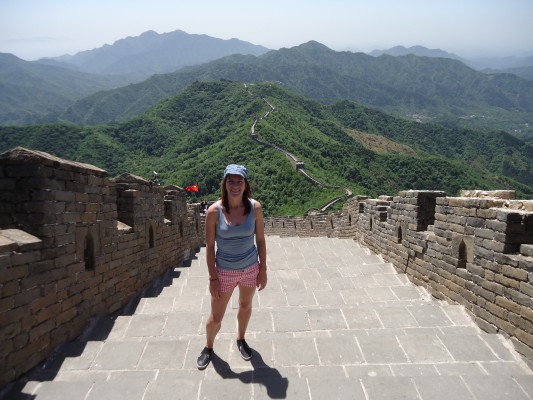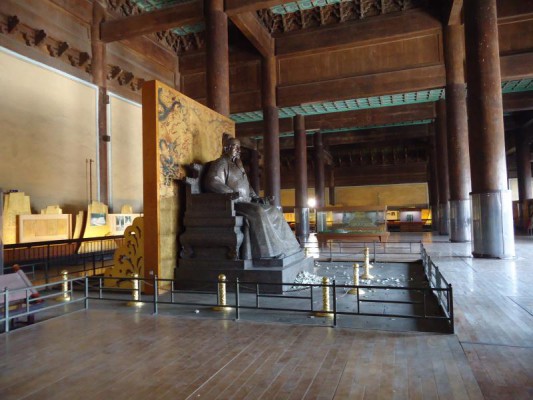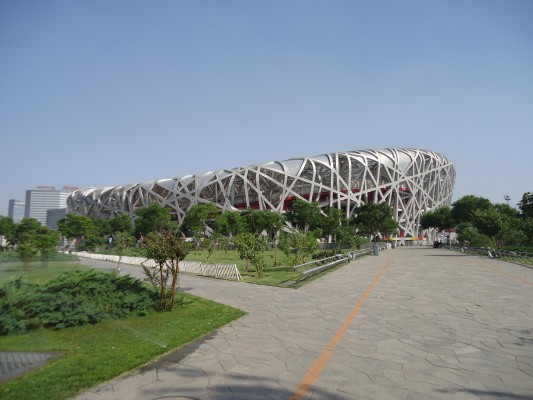China’s capital is a cultural jewel with fascinating historical sites scattered in and around the city. With so many locations worth exploring it’s hard to know where to start. You would need a lot more time than I had there to see everything, but here are the 8 things I managed to fit into three action packed days in Beijing.
The Great Wall of China
This was the number one item on my list for my trip to China and didn’t disappoint. The Great Wall is truly one of the most amazing things I’ve ever seen. Only two hours outside of the city, it could have easily been another world. Crowded streets and smoggy skies were replaced with green mountains stretching in every direction and the stone wall running along them one of the only structures in sight. I visited the Mutianyu section, which consists of a 2.5 km restored stretch of wall open for visitors to explore and 22 watchtowers at 100m intervals. This section of the wall was used to defend the capital and nearby tombs. Merlons are built into both sides of the wall, meaning shots could be fired at enemies approaching from either direction. With less visitors than other sections of the wall, we managed to get moments to ourselves for some spectacular photos.
We caught the cable car up, although it is possible to walk. Going during summer meant it was very hot while walking, and some sections are very steep. A long stretch of near vertical stairs takes you high up on the mountain. The climb was tough, but the view was worth the effort. The Mutianyu section is surrounded by an abundance of greenery covering the mountains and valleys on either side of the wall.
Entry – 45 RMB
Cable Car round trip – 80 RMB
Ming Tombs
A total of 13 tombs belonging to Emperor’s of the Ming Dynasty are scattered around Beijing. I visited Changling Tomb, the first and most well preserved of the Ming Tombs. Located about 50 kilometers from Beijing, Changling Tomb can be combined with the Great Wall for a fantastic day trip out of the city. Changling Tomb is the tomb of Emperor Zhu Di, the most significant emperor of the Ming Dynasty and his empress. The tomb was completed in 1427, and occupies an area of approximately 120,000 square meters.
The main building of the tomb, Ling’en Hall, is made from a rare kind of wood that has been preserved from the Ming Dynasty. The hall features an impressive statue of Emperor Zhu Di, sitting on a throne decorated with dragons. The room is filled with a collection of objects and photos detailing the achievements of Emperor Zhu Di, including moving the capital to Beijing and constructing the Forbidden City.
Forbidden City
The Forbidden City, or Imperial Palace, was home to 24 emperors during the Ming and Qing dynasties. You could spend a full day, or more, exploring the city, but my tight schedule in Beijing meant we had an afternoon to fit in as much as possible. Construction of the city began in 1406 when Emperor Zhu Di moved the capital back to Beijing from Nanjing in southern China. The palace was remained the political centre of China until 1912, despite damage to parts of the city during the shift between the Ming and Qing dynasties, and occupation by foreign forces in the second Opium War and Boxer Rebellion. After becoming a World Heritage Site, the Palace Museum commences a restoration project to return the city to its historical state.
Consisting of massive courtyards and impressive palaces, the city seems to stretch on forever. The restoration project means the buildings boast striking colours and detailed patterns that give the site a distinct visual appeal. The gardens at the back of the site offer a shady retreat from the sunny courtyards that was a welcome escape on the 36 degree summer day I visited. Featuring smaller pavilions and unique statues, it is easy to get lost in imagining what life may have been like for the Emperors and Empresses who lived in the palace.
Entry – 60 RMB
Tiananmen Square
Across the road from the Forbidden City is Tiananmen Square. Both are easy to access using Beijing’s subway, and their close proximity to each other makes for a good day trip. Despite the heat, the area was crowded and buzzing with activity. The Monument to the People’s Heroes stands tall in the centre of the square, with visitors huddled around for photos. Groups of people were gathered around food vendor vans and laughter and chatter from the crowd could be heard ringing out across the square. The lack of chairs and trees in the square meant people were lined in the small strips of shade provided by lampposts and flagpoles as they waited for the symbolic lowering of the flags at sunset.
The square is surrounded by a number of important buildings in addition to the Forbidden City. The National Museum of China is one side, while the Great Hall of the People stands on the other. The heavy security serves as a reminder of the events that have taken place in the square, including a strong police presence and bag scanning at entrance points.
Summer Palace
I almost couldn’t believe it when I was told that the Summer Palace was bigger than the Forbidden City. It seemed impossible that anything could compare with the mammoth stretch of buildings and courtyards that made up the Forbidden City, but it didn’t take long to see that the Summer Palace definitely did. The literal translation of the name means “Gardens of Nurtured Harmony”. I’m not sure why that didn’t make it into the English name, but Summer Palace sounds impressive enough to represent what this stunning site has to offer.
The Summer Palace is a former imperial palace and was later a holiday resort for Empress Dowager, who saw the reconstruction of the palace after it was damaged during the Anglo-French invasion in 1860 and the eight allied nations invasion in 1900. Centered around the man made Kunming Lake, the palace features a collection of temples, houses and bridges, lined with leafy gardens. The picturesque setting heightens the feeling of retreat from the outside world, the hustle and bustle of one of the world’s busiest cities seemingly miles away. Rising above the lake are the site’s most iconic buildings, the Temple of Buddhist Virtue and the Tower of Buddhist Incense. The climb to the top rewards you will views over the lake, it’s best on a clear day.
Entry – 50 RMB
The Gardens of Perfect Brightness
Otherwise known as the old Summer Palace, this was something I will admit to having no knowledge of before going to Beijing, but something that is an extremely important part of China’s history and worth visiting. Like the nearby Summer Palace, the beauty of this location is undeniable. The palace was used by emperors of the Qing Dynasty and contained extensive architecture, lakes and gardens. One of the gardens, the Garden of Eternal Spring featured European style buildings, which were built at the request of the Qianlong Emperor. However the majority of buildings that made up the palace were traditional Chinese style structures.
In response to a group of British and Indian troops being taken hostage and killed during the second Opium War, the palace was destroyed by British and French troops. The garden was set ablaze and burnt for three days and the buildings were looted. The palace was destroyed again in 1900 during the Eight Nation Alliance invasion. Unlike the Summer Palace, this garden was not restored after the attacks, and visitors can see the full effect of the destruction with damaged buildings left in the condition that resulted from the invasions.
Entry – 25 RMB
Beijing Olympic Park
I have great memories from having an Olympics on my doorstep in 2000, so a visit to Beijing Olympic Park was a must do for my trip.
The iconic “Bird’s Nest” stadium is as impressive up close as it is on television, and the fountains dancing in front of it make for a great people watching opportunity. The water cube is best viewed at night when its striking blue colour is illuminated. Walking to the cauldron will take you past a long wall listing the medalists from 2008 – searching through the names to see who you can find might be slightly nerdy, but was also a lot of fun.
Eat Local!
Watching bizarre foods Beijing the other night was a good reminder of some of the interesting street food in this city. I didn’t go to the night markets, but visited Wangfujing pedestrian street with its famous snack street. The narrow street is tightly packed with crowds and an almost overwhelming mix of wafting scents coming from the countless street stalls and restaurants. Those brave enough to try anything will not be disappointed – seahorses, starfish and various kinds of bugs on skewers were in almost every store. I’ve seen my fair share of unusual snacks in Central American markets, but I wasn’t prepared for the scorpion skewers, with the still live animals wiggling around on the sticks as we walked by.
I went for a much safer option with my street food purchase, choosing a lamb skewer and a fruit skewer that consisted of a small red fruit covered in hardened candy (Tanghulu). My dentist might have been horrified if they saw it, but it tasted amazing.
Another must try item is Beijing’s famous Peking Duck. Served in China since the Imperial times, Peking Duck is known for the crisp skin and unique style of serving where the duck is sliced in front of the diners. The meat and skin are served separately, the skin often eaten with various sauces. The meat is rolled up into a think pancake and eaten with cucumber sticks. There are many restaurants throughout Beijing that serve Peking Duck. We ate at Bianyifang, one of the longest serving duck restaurants in Beijing, currently located in the New World Shopping Mall.
Written by Bronwyn Hager www.whereisbron.com
Book your accommodation in Beijing with HI Hostels here.











